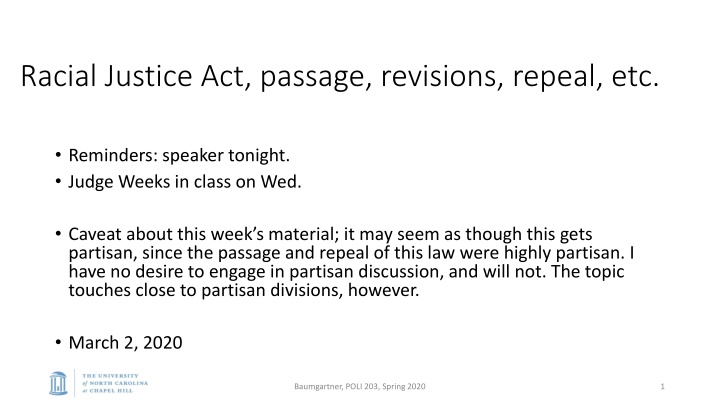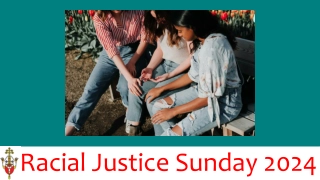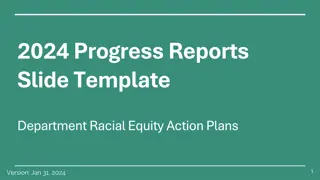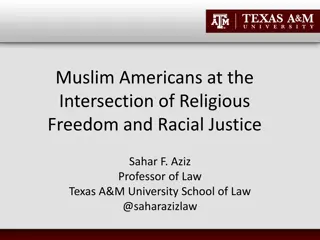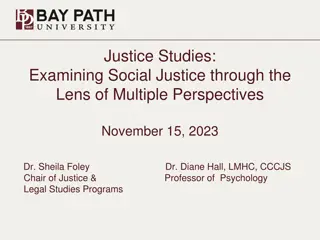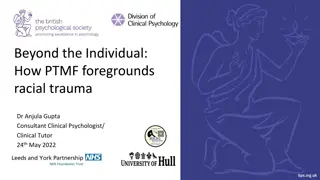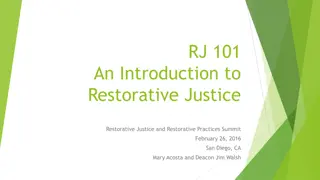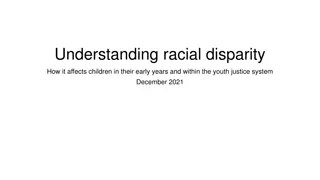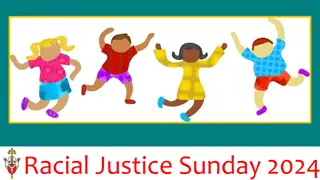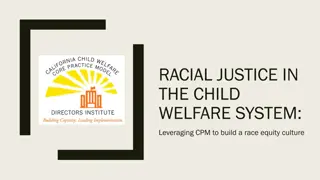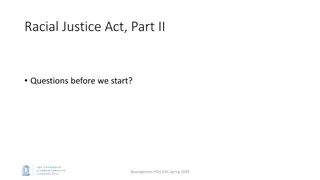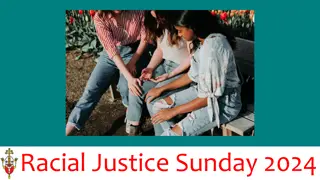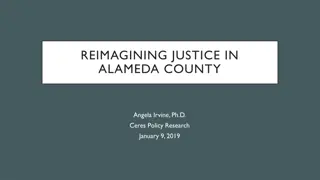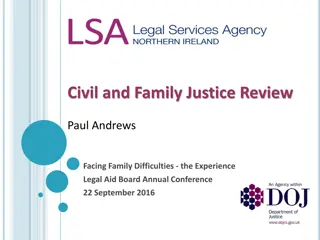Challenges and Progress of Racial Justice Act Implementation
Explore the journey of the Racial Justice Act, from its controversial passage to subsequent repeal, and the legal battles surrounding statistical evidence in discrimination cases. Delve into pivotal court cases and legislative lobbying efforts that have shaped the discourse on racial disparities in the criminal justice system.
Download Presentation

Please find below an Image/Link to download the presentation.
The content on the website is provided AS IS for your information and personal use only. It may not be sold, licensed, or shared on other websites without obtaining consent from the author.If you encounter any issues during the download, it is possible that the publisher has removed the file from their server.
You are allowed to download the files provided on this website for personal or commercial use, subject to the condition that they are used lawfully. All files are the property of their respective owners.
The content on the website is provided AS IS for your information and personal use only. It may not be sold, licensed, or shared on other websites without obtaining consent from the author.
E N D
Presentation Transcript
Racial Justice Act, passage, revisions, repeal, etc. Reminders: speaker tonight. Judge Weeks in class on Wed. Caveat about this week s material; it may seem as though this gets partisan, since the passage and repeal of this law were highly partisan. I have no desire to engage in partisan discussion, and will not. The topic touches close to partisan divisions, however. March 2, 2020 Baumgartner, POLI 203, Spring 2020 1
Courts unresponsive to statistics McCleskey v. Kemp, 1987 Baldus study: review of all Georgia death-eligible cases, same as Donohue did for Connecticut (2,500 murders, 39 non-racial variables, killers of whites 4.3 times more likely to be sentenced to death in Georgia than killers of blacks) (Attorney arguing the case before the USSC: Jack Boger, until recently the Dean of UNC Law School, now retired) McCleskey v. Kemp: the Dred Scott of the 20thcentury. Statistics don t matter. Must prove intent to discriminate in the individual case. McCleskey as the bitter end or a litigation strategy based on racial disparities Huge legal investment in this idea, from 1940s through the 1980s, ends in complete failure Baumgartner, POLI 203, Spring 2020 2
Batson v. Kentucky (1986) You may not reject all the blacks from the jury pool. OK, great. However, no such challenge has ever been successful. Flowers v. Mississippi (2019) was really the first big one. Maybe we are seeing a shift. DA must provide a reason other than race to strike the person. He shuffled is accepted. He s a member of the NAACP is accepted. Baumgartner, POLI 203, Spring 2020 3
So a turn to the legislature If the US SC will not use statistical evidence, pass a law specifically to allow this From lawyering to lobbying Baumgartner, POLI 203, Spring 2020 4
Lobbying the General Assembly in 2009: Bo Jones, Jonathan Hoffman, Ed Chapman, Darryl Hunt Baumgartner, POLI 203, Spring 2020 5
Feb 2001 RJA proposed Rep. Ronnie Sutton (D-Pembroke) Passed through committees, postponed indefinitely in Oct 2002 Baumgartner, POLI 203, Spring 2020 6
April 2007 Larry Womble, Earline Parmon, (D-Forsyth) Died in committee Baumgartner, POLI 203, Spring 2020 7
March 2009 Floyd McKissick Jr (D-Durham) (Note: his dad was the first Black student at UNC Law) Legislative Black Caucus pushes hard Baumgartner, POLI 203, Spring 2020 8
Outside actors NAACP, Rev. Barber, much more aggressive, public tone of pressure than previous president of NAACP Death penalty reform advocates Had already had lots of successes restricting use, many reforms since 2000 / 2001: eyewitness ID reform, discretion not to seek death, creation of Innocence Inquiry Commission, and so on Democratic caucus has a closed session, people come out unanimously in favor. Black caucus within the democratic party: Don t think representation does not matter; it does. Baumgartner, POLI 203, Spring 2020 9
Timing is everything NC as a leader in reforms from 2000 through 2009, eyewitness ID, many other reforms Exonerations: lots of them here in NC Lobbying by exonerees, including Bo Jones, Darryl Hunt, Jonathan Hoffman, Ed Chapman Baumgartner, POLI 203, Spring 2020 10
2009 RJA Read the law, it is only 3 pages long Show racial disparity in: Decision to seek or impose death: In the county, prosecutorial district, judicial division, or state At the time that death was sought or imposed Baumgartner, POLI 203, Spring 2020 11
Relevant evidence to demonstrate disparities Statistical or other evidence including but not limited to: Sworn testimony of attorneys or other members of the criminal justice system Baumgartner, POLI 203, Spring 2020 12
Any of three findings Inmate s race Victim s race Peremptory challenges in jury selection Baumgartner, POLI 203, Spring 2020 13
Kentucky passed the first Racial Justice Act (1999), but it was severely watered down From the Winston Salem Journal, Dec 25, 2011: The North Carolina and Kentucky laws, although they are known with the same name, couldn't be more different. The law in Kentucky isn't retroactive for defendants sentenced to death before 1998, and they can only raise a claim before a trial. They also have to prove by clear and convincing evidence that racial bias played a role in their individual case, which limits the use of statewide statistics. The law also prohibits defendants from claiming racial discrimination in a jury's decision to impose the death penalty. Baumgartner, POLI 203, Spring 2020 14
States seek death, juries impose it Thinking back to Deadly Justice, chapter 4 on racial bias, you will see separate analyses of: DA s decision to seek a death sentence (e.g., charging ) Juries decisions to impose death ( sentencing ) Should we constrain the actions of jurors? Kentucky said no. Is the jury a state actor? Interesting philosophical / legal question. Baumgartner, POLI 203, Spring 2020 15
OK, what is clear and what is not clear about the NC RJA? Clear: Inmate Victim Jury selection Statistical evidence can be used Baumgartner, POLI 203, Spring 2020 16
Unclear, needs to be litigated What if I show bias in the county, but the state rebuts that there is no bias in the district or state? What if I show bias in a certain time frame? Which time frame is appropriate? Can t just be the day of my trial, obviously. What if the state counter-argues that it was 10 years ago, and therefore not relevant, or in a different county / judicial district? Baumgartner, POLI 203, Spring 2020 17
What is enough disparity? 40% for whites v. 41% for blacks? Is that enough? Judge has to rule on this, unclear Judge Weeks: BOTH statistically significant at .05 level (1 in 20 chance of occurring by random chance), AND a 20 percent difference in value. This was taken from employment law. (His ruling shows that for jury strikes, the actual probability level was more like 1 in 10,000,000,000,000,000,000,000,000,000,000.) Baumgartner, POLI 203, Spring 2020 18
10,000,000,000,000,000,000,000,000,000,000. ten commas? 1: thousand 2: million 3: billion 4: trillion 5: quadrillion 6: quintillion 7: sextillion 8: octillion 9: nonillion 10: decillion So the odds were 1 in 10 decillion, not very likely. Baumgartner, POLI 203, Spring 2020 19
How to rebut? Statistical evidence, clearly But also sworn testimony of people involved in the system I did not intend to discriminate We have programs in place to eliminate discrimination Unclear how such evidence would / should be weighed by a judge or the NC SC Baumgartner, POLI 203, Spring 2020 20
How did this ever pass??? O Brien and Grosso article Lots of mobilization Evolution of the argument following McCleskey Dissatisfaction with the Batson ruling, or lack of enforcement Large black caucus in the Democratic Party; party-line vote. Post-passage controversies That party-line vote was a recipe for repeal as soon as the majority changed. Baumgartner, POLI 203, Spring 2020 21
What happened after it passed First surprise: almost everyone on death row appealed Something like 145 of 150 inmates appealed White on white cases as well as others. (Does that make sense? It does to me; a disparity is a disparity and life and death should not hinge on it. But anyway the cases all hinge on jury selection, not race effects for inmates and victims.) Second, it becomes a political football (no surprise). However, the focus on Hugh Holliman is a surprise. He was defeated for reelection. Third, the CDPL and others mount a massive fund effort to get a study done in 12 months: thousands of murders analyzed, a Baldus study. But the focus is on jury strikes. Evidence is overwhelming. Baumgartner, POLI 203, Spring 2020 22
In 2011, the Republican Party takes over both chambers, for the first time in recent history. Percent Democrats in NC General Assembly Over Time 90.00 80.00 70.00 60.00 50.00 40.00 30.00 20.00 10.00 - 1993 1995 1997 1999 2001 2003 2005 2007 2009 2011 2013 2015 2017 Senate House Majority Baumgartner, POLI 203, Spring 2020 23
Hugh Holliman entered politics because of his daughter s murder by Ricky Sanderson http://www.wral.com/news/local/story/123265/ http://www.wral.com/news/local/story/123357/ Ricky Sanderson was executed in 1998. Holliman and Sanderson visited in prison, and prayed together. Holliman was present when Sanderson was gassed. Baumgartner, POLI 203, Spring 2020 24
Hugh Holliman the target of these ads, defeated in 2012 Baumgartner, POLI 203, Spring 2020 25
So many ironies Hugh Holliman as the target Henry McCollum as the threatening inmate (he was exonerated in 2014 after 30 years) Suggestion that people would go free (much less move into your neighborhood ) But race, crime, capital punishment are potent scare dynamics in elections. Holliman was defeated. Baumgartner, POLI 203, Spring 2020 26
Legal Strategy Focus on the jury venire members not allowed to exercise their constitutional right and responsibility to be on a jury Avoid the race-of-victim litigation Avoid the race-of-inmate question No one can argue that black citizens should not have an equal right to be on a jury. Since that was in the law, it was low-hanging fruit because it s pretty standard practice to eliminate most blacks from capital juries Baumgartner, POLI 203, Spring 2020 27
4 cases make it to trial First case: approved on the basis of jury selection (Marcus Robinson) Next 3 cases combined, one involved the killer of a police officer. Also successful on the basis of jury selection 2015: cases overturned on the basis that the judge should have allowed more time for the prosecutors to submit their evidence. 2018: NC SC agrees to hear the appeals of the 4 inmates who had been returned to death row. The case is pending. Baumgartner, POLI 203, Spring 2020 28
One of the RJA cases involved the killing of an NC state trooper. Many troopers were in the courtroom when Judge Weeks ruled in favor of the inmate. Baumgartner, POLI 203, Spring 2020 29
Where we stand 4 cases were heard, then the law was repealed Can you take away a right, once granted? In other words, do the 142 inmates who filed in 2009 have the right to have their cases heard, even though the law is no longer in effect? The four cases that were heard, and which were successful, are to have new hearings. But the law is no longer in effect They are currently back on death row. The NC SC heard arguments on the four cases, in August 2019 If they find in favor of the 4, what about the 142 others who sought relief, under a law which has since been rescinded? What a mess! Baumgartner, POLI 203, Spring 2020 30
Restoring Proper Justice Act Kick-start the execution machinery Look at the law on the web site and consider Is this cheap talk ? That is, are there so many legal hurdles to making this happen that it simply allows politicians to take a stand without actually worrying about making it happen? Or, even if it is not going to happen, is there a large constituency for bringing back executions? The symbolic value of the death penalty Baumgartner, POLI 203, Spring 2020 31
A political football This case has clearly been affected by partisan politics and electoral considerations Big, unsuccessful, push to get Gov. Perdue to commute all death sentences before she left office in Jan 2013. She declined. No firm statements from Dem. Gov. Roy Cooper or Dem. Attorney General Josh Stein that they firmly oppose capital punishment. On the other hand, the death penalty may not be the driving force that it once was for those who want to demonstrate a tough on crime stance. Republican party sees it as a positive, and Democratic party is not very clear on its position. Baumgartner, POLI 203, Spring 2020 32
